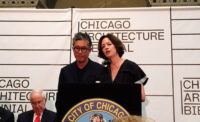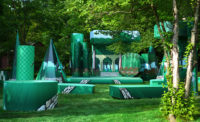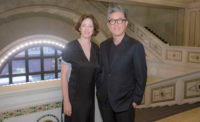Chicago Architecture Biennial Curators Offer a First Glimpse of 2017 Installations

Paper Study Models by Stan Allen Architect.
Image courtesy Stan Allen Architect

Biennial participant AGENdA agencia de arquitectura designed this installation at the Mexico City-based architecture gallery LIGA 25.
Photo © Luis Gallardo

Gypsum cast model for A TOWER by 2017 Biennial participant Studio Anne Holtrop.
Image courtesy Studio Anne Holtrop

2017 CAB co-curators Sharon Johnston and Mark Lee.
Photo © Eric Staudenmaier




If the 2015 debut of the Chicago Architecture Biennial offered a compelling survey of the most intriguing practices around the world, said 2017 co-artistic director, Mark Lee, this year’s exhibition will coalesce around a more cohesive theme, Make New History. “We compare it to a restaurant; the first time you go into a restaurant, you try the tasting menu. You try everything. The second time you concentrate more on one way of consuming,” he said, speaking after a curatorial presentation held yesterday at the Graham Foundation on Chicago’s Gold Coast.
On the third floor of the organization’s Prairie-style mansion, Lee and co-artistic director Sharon Johnston of the L.A. firm Johnston Marklee revealed a first glimpse of significant installations and programming highlights of the 2017 edition, which will include 141 firms from 20 countries and span six museums and three yet-to-be-announced off-site locations. Borrowed from a book of empty white pages by Los Angeles-based artist Ed Ruscha, the theme “suggests history is yet to be written,” Lee said, embracing architecture as “something very physical or visceral as opposed to seeing things that are representational of through a screen.”
Biennial chairman Jack Guthman, a Chicago land-use attorney and arts advisor, said the event will reach into surrounding communities through civic and educational programs for disadvantaged middle and high school students and align with EXPO Chicago, the International Exposition of Contemporary and Modern Art, which will run September 13-17 at Navy Pier. “We had more time, and we saw where we had opportunities to expand the biennial both for our international audience and our local audience,” Guthman said.
According to Lee, the exhibition’s installations will fall into four categories: building histories, image histories, material histories, and civic histories. The first will look “to canonical history but also anonymous history” for inspiration and include works ranging from Sylvia Lavin’s recreated representations of architectural models, now stored in the German Architecture Museum in Frankfurt, to Shanghai-based Zao/standardarchitecture’s Hutong courtyard studies. Image histories, Johnston explained, will focus on the role of representation in architecture, including renderings by Belgium-based Office and Dogma, Atelier Manferdini’s wallpaper skins, and Mollet Geiser’s (MG&CO) Rooms for Books, which will include a public archive of Stanley Tigerman and Margaret McCurry’s prolific book collection. Material history will delve beyond offices and skyscrapers to examine archaic mediums.
“As much as we admire the 2014 Venice Biennale directed by Rem Koolhas, Fundamentals, many of the projects were forced into this one-hundred-years narrative. This is a historicist’s way of fitting everything in a meta-narrative structure. Whereas when we look back to the presence of the past, history is almost treated as a large horizon where people can enter in different ways,” Lee said.








